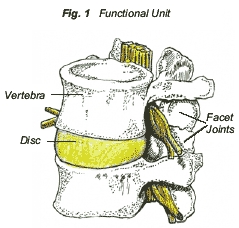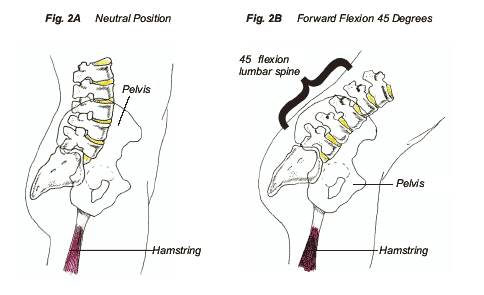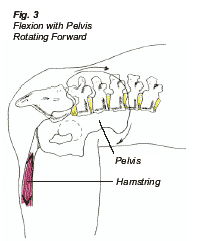 Most people suffer from low back pain at some time in their lives. Common cases of low back pain include people who work in a prolonged flexed posture while sitting at a computer, or the “weekend warriors” who attempt to participate in activities such as golf, biking, and basketball without a proper training program.
Most people suffer from low back pain at some time in their lives. Common cases of low back pain include people who work in a prolonged flexed posture while sitting at a computer, or the “weekend warriors” who attempt to participate in activities such as golf, biking, and basketball without a proper training program.
Understanding the biomechanics of the lumbar spine and pelvis while bending forward and returning to the neutral position will illustrate why the loss of strength and flexibility in particular muscles predispose individuals to the development of low back pain.
Movement 1: Anterior Flexion of the Lower Back
The low back consists of five functional units. A functional unit (Fig. 1) consists of two vertebra, an adjoining disc, facet joints, and the surrounding musculature, ligaments and fascia.
Ligaments attach bone to bone, and fascia is a sheath of fibrous tissue that encloses muscles and muscle groups. There is approximately 9 degrees of flexion at each functional unit, allowing up to 45 degrees of forward flexion (Fig. 2A & 2B).

At 45 degrees, the fascia, muscles, and ligaments of the low back are taut and no more flexion is allowed without forward rotation of the pelvis. An endpoint of motion in forward flexion of the low back is the point at which a person bends forward and can go no further pain. If the ligaments, fascia, muscles of the low back are not flexible, this endpoint of motion will be decreased and will result in a strain/ injury of the low back when attempting to bend forward to 45 degrees. In order to bend forward past 45 degrees, the pelvis has to rotate forward (Fig. 3).


The anterior motion of the pelvis is dependent on the flexibility of the hamstrings and the gluteus maximus musculature. If the hamstrings and gluteus maximus musculature are not flexible, the pelvis will be limited in anterior flexion (Fig. 4). When this limited endpoint of forward flexion is exceeded, one will usually suffer from an acute onset of low back pain.
Movement 2: Return to Neutral Position from Flexion of the Low Back
When returning from a flexed low back posture, the gluteus maximus muscle (Fig. 5) will contract, derotating the pelvis from its anteriorly rotated. At the same time, the abdominal musculature contracts, tightening the fascia surrounding the low musculature, adding more stability to the lumbar spine.
Movement 1 and Movement 2 illustrate why flexibility of the lower back and hamstring musculature and proper strength training of the gluteus maximus and abdominal musculature are important in the prevention of low back pain. Having flexibility of the hip and external rotators of the hip, as well as strength in the quadracep can also aid in the prevention of low back pain.
Case Study
Bob came to Dr. Dubin’s office for care with complaints of low back pain. He stated that he worked as a stockbroker and sat looking at a computer screen all day. His low back pain came on gradually and became more severe with time. He did not belong to a gym, nor did he do a strength and flexibility training program at home.
Dr. Dubin conducted a thorough exam on Bob’s lower back to diagnose his condition. The treatment techniques utilized by Dr. Dubin at his office included: specific deep tissue procedures (active release technique) applied to the muscles in the low back to free up soft tissue motion; adjustments to free up joint motion; and combotherapy to help to relax the muscles, restore normal muscle tone, and break up scar tissue. Dr. Dubin tailored a home flexibility program for Bob involving the FlexBand® and a proper strength training program. Bob was also instructed on how to ergonomically correct his workstation to help alleviate the repetitive strain on his low back. Bob now does stretching exercises with the FlexBand® for 15 minutes a day (see below) and a regular (1-2 times a week) strengthening program for his low back. Bob’s low back pain has resolved, and his ongoing workout routine will continue to help in the prevention of future low back episodes.
How to Relieve Low Back Pain
Repeated, prolonged stress to the back and shoulders can lead to a multitude of injuries down the road. Most jobs require a prolonged (sitting or standing) slumped forward position, which results in a postural overstretch and eventual low back pain. Decrease and prevent lower back pain by doing a 15 to 20 minute daily stretching routine using a FlexBand®. These exercises will help prevent your low back pain.

